Affiliate links on Android Authority may earn us a commission. Learn more.
Mobile Processor Guide – Summer 2013

A fair bit has changed in the mobile processor space since we last took a look at the market earlier in the year. New handsets have been released, new benchmarks leaked, and a few brand new SoCs have been unveiled too.
So here’s a round-up of all the mobile processor news for the second quarter of the year.
The next generation
Earlier in the year, we were eagerly awaiting the arrival of processors powered by ARM’s new Cortex A15 CPU cores, which were promising substantial performance improvements over the old Cortex A9 generation. Most of the big chip manufactures were lining up their new SoCs, the Exynos 5 Octa and Snapdragon 600 were two of the biggest releases which we’ll take a look at in a bit more detail in a minute, and all the tech junkies were eager to know exactly what these chips could do.
Well, now we know, one of the most obvious changes over the past quarter has been the leap up in mobile processing power. Top of the line handsets launched around the start of the year, like the Xperia Z, have already be surpassed with faster pieces of hardware — just take a look at our benchmark results:
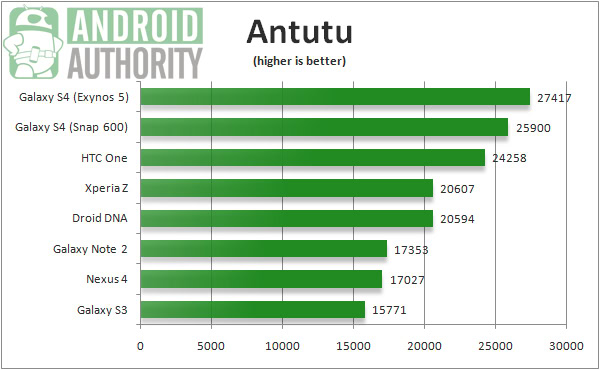
The Cortex A15 may have been the big step forward for mobile processes so far this year, but its implementation has come in many different forms.
Qualcomm Snapdragon
Qualcomm continues to do what Qualcomm does best – produce a range of high quality chips with everything that handset manufactures need already built in. This time last quarter, we were taking our first look at the upcoming Snapdragon 600 processors which would be replacing the older S4 Pro, another incredibly popular Qualcomm processor.
Qualcomm doesn’t use the exact specification for the Cortex A15, it licenses the architecture from ARM which it then implements into its own Krait CPU cores, the newest version of which, the Krait 300, has shown up in the new Snapdragon 600 SoC.

Since then, a range of handsets powered by Qualcomm’s newest chips have appeared on the market, the flagship Samsung Galaxy S4 and HTCOne being the two most notable models which are both some of the best performing smartphones on the market. Performance wise, the Snapdragon 600 has proven to be a decent enough jump up from the previous generation, performing well in most benchmark tests.
We’ve also started to hear about a few devices featuring the lower end Snapdragon 400 and 200 chips, with a range of entry level processors using various ARM architectures heading to the market in the near future. So far this year high end smartphones have received the biggest performance improvements, but these new chips should give the midrange a much needed boost later in the year.
So whilst Snapdragon 600 is certainly the most popular high-end chip on the market right now, we’ve already started to see our first snippets at Qualcomm’s next big thing, the Snapdragon 800.
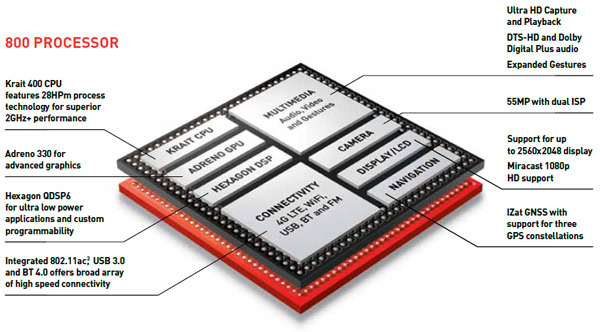
There’s been lots of official and unofficial data floating around over the past few months regarding this new chip, and from, what we can tell, it looks to be one powerful piece of tech. Qualcomm demoed some of the new chip’s improved 3D performance earlier in the year, and more recently we’ve seen a few benchmarks popping up for new devices, which place the Snapdragon 800 at the top of the benchmark scores come it’s release.
First, there was the Pantech IM-A880 smartphone, which scored an impressive 30133 in the popular Antutu benchmark, followed by the rumoured beefed up version of the Galaxy S4, and most recently the new Xperia Z Ultra which pulled in the most impressive score yet, a whopping 32173. We’ve also seen some more official looking benchmarks from AnandTech and Engadget which confirm the Antutu scores of above and around 30,000, and also gives us a good look at how the chip performs in a range of other tests. The conclusion — it’s a bit of a beast.
These notable benchmarks scores are no doubt down to the new higher clocked Krait 400 CPU cores and the new Adreno 330 GPU, which is supposed to offer around a 50% performance improvement over the already quick Adreno 320. The test results we’ve seen have shown that the Snapdragon 800s CPU is fine compared with the current crop of processors, but the chip really shines through when it comes to GPU performance, which has proven to be even quicker than the Tegra 4 and iPad 4 chips.
We’ve already seen that Qualcomm is taking graphics extra seriously with its latest chip, as the Snapdragon 800 became the first processor to receive OpenGL ES 3 certification and is compliant with all the big graphics APIs.
Quite a few upcoming top of the line handsets are rumored to be utilizing Qualcomm’s latest processor, including the Galaxy S4 LTE-A, OPPO Find 7, and an Xperia Z refresh as well, so the Snapdragon 800 is perhaps the biggest chip to look out for in the coming months.
Exynos 5 Octa
Moving away from Qualcomm, there was certainly a lot of hype surrounding Samsung’s octo-core monster of a processor. Upon release, the chip mostly lived up to expectations — the Exynos version of the Galaxy S4 topped our performance charts and is currently the fastest handset on the market. The SoC is the first to utilize the new big.LITTLE architecture, with four new Cortex A15 cores to provide top of the line peak performance, and four older low power Cortex A7s to keep idle and low performance power consumption to a minimum.
The chip is certainly one of the best when it comes to peak performance, but it has had its share of troubled when it comes to balancing power consumption and performance.

If you’re in the market for the fastest smartphone currently around, then the Galaxy S4 is the one to pick right now, providing that it’s available in your region. It has the fastest CPU currently on the market, and its PowerVR SGX544 tri-core GPU matches that of the latest iPad. But with the Snapdragon 800 just around the corner, there could soon be a new processor sitting on the performance throne.
Looking forward, it’s difficult to see the Exynos retaining its top spot for much longer. Other companies are starting to look beyond the power-hungry Cortex A15 architecture, but Samsung hasn’t yet unveiled any new plans.
Intel Clover Trail+ and Baytrail
Speaking of which, perhaps the biggest mover this year has been Intel, and although the company still isn’t competing with ARM in terms of the number of design wins, Intel has finally show off some products which will pose a threat to ARM’s market dominance.
Although we’ve been hearing about Clover Trail+ since last year, the chip is now moving into full swing, with a few handsets arriving which are running the chip, and some of the benchmarks we’ve seen are really quite impressive. Clover Trail+ has managed to find the right balance between performance and power consumption, unlike previous Atom chips which been far too slow to keep up with the top of the line ARM-based processors.

Then there’s Baytrail. Back at Mobile World Congress earlier in the year, Intel laid out its plans for its Clover Trail+, but we’ve already heard information about the processor’s successor. Intel claims that its new Silvermont cores will further improve on both energy efficiency and peak performance. It sounds great on paper, but we always have to take these unveilings with a pinch of salt. What we are most likely looking at with Baytrail is a decent performance improvement, which should keep the processor ahead of the current Cortex A15 powered handsets in the benchmarks, but energy improvements are likely to come in the form of idle power consumption and low power states, rather than saving energy at the peak performance levels.
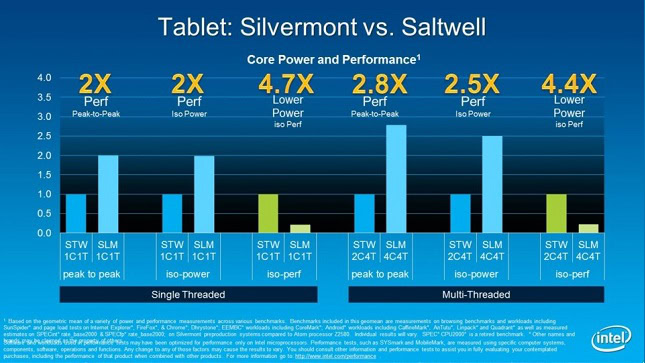
But Intel isn’t just interested in breaking into the smartphone and tablet markets with its new line-up of processors. The company is still very much focused on producing chips for laptops. One particularly interesting prospect is the confirmed new generation of Android based netbooks and laptops powered by more robust Intel processors, which could give Microsoft a real run for their money.
Intel has clarified that it will also be assigning the additional Pentium and Celeron titles to its upcoming Silvermont architecture as well as using it in the new BayTrail mobile chips. What this potentially means is a further blurring of the line between tablets and laptops, where the same processor technology will be powering a range of Intel based products. I’m expecting the performance rankings to go from Baytrail for phones and tablets, to Celeron for notebooks, and Pentium chips for small laptops, but this naming strategy hasn’t been confirmed yet. It’s also interesting to see where this will stack up with Intel’s newly released Haswell architecture, which is also aimed at providing power efficient solutions to laptops.
Taking all that into consideration, Baytrail has the potential to be a big game changer for Intel, as it could stand out well ahead of Samsung’s top of the line Exynos chips and will certainly rival the upcoming Qualcomm Snapdragon 800 processor. But we’ll be waiting until the end of the year before we can finally see what the chip can do. In the meantime, we’ll look forward to seeing if Clover Trail+ can finally win over some market share.
NVIDIA Tegra 4 and 4i
Nvidia, on the other hand, has had a much more subdued second quarter of the year. We already had many of the unveilings for its new Tegra 4 and Tegra 4i designs by the start of the year, and so far, no products have launched which are making use of NVIDIA’s latest chips.
But we have seen quite a bit about NVIDIA Shield, which will be powered by the new Tegra 4 chip, and it certainly looks to be a decent piece of hardware. There have also been some benchmarks floating around suggesting that the Tegra 4 is going to significantly outpace other Cortex A15 powered chips, but, without a significant boost in clock speeds, I doubt that the chip will be much faster regarding most applications.
Nvidia’s real strength obviously lies in its graphics technology, and the Tegra 4 certainly has that in spades. NVIDIA, much like Qualcomm, has focused on making its new graphics chip compatible with all the new APIs, like OpenGL ES 3.0 and DirectX 11, which will allow the chip to make use of improved graphical features when gaming. But it’s unclear as to whether that will be enough to win over manufactures or consumers.
The Tegra 4i has been similarly muted, without any handsets yet confirmed to be using the chip and we haven’t really heard much about performance either. We already know that the Tegra 4i certainly isn’t aiming to compete with top of the line chips, as it’s only the older Cortex A9s in its quad-core, but with other processors already offering LTE integration, it’s tough to see smartphone manufactures leaping at NVIDIA’s chip.
The Tegra 4 is set for release at the end of this quarter, with the Tegra 4i following later in the year. But such a delayed launch may see NVIDIA risk missing the boat on this generation of processors as well, which may have something to do with NVIDIA’s biggest announcement so far this year – its plan to license its GPU architecture.
This change in direction has the potential to turn NVIDIA into the ARM of the mobile GPU market, allowing competing SoC manufacturers, like Samsung and Qualcomm, to use NVIDIA’s graphics technology in their own SoCs. However, this will place the company in direct competition with the Mali GPUs from ARM and PowerVR GPUs from Imagination, so NVIDIA’s Kepler GPUs will have shine through the competition. But considering the problems that the company had persuading handset manufacturers to adopt its Tegra 3 SoCs, this seems like a more flexible and potentially very lucrative backup plan rather than spending more time and money producing its own chips.
MediaTek Quad-cores
But it’s not just the big powerhouse chip manufactures that have been introducing some new tech. MediaTek, known for its cheap lower performance processors, has recently announced a new quad-core chip named the MT8125, which will be targeted for use in tablets.
The new processor is built from four in-order ARM Cortex A7 cores clocked at 1.5Ghz, meaning that it’s not going to be an absolute powerhouse when it comes to processing capabilities. The SoC will also be making use of a PowerVR 5ZT series graphics chip, which will give it sufficient grunt when it comes to media applications as well, with support for full HD 1080p video playback and recording, as well as some power when it comes to games.
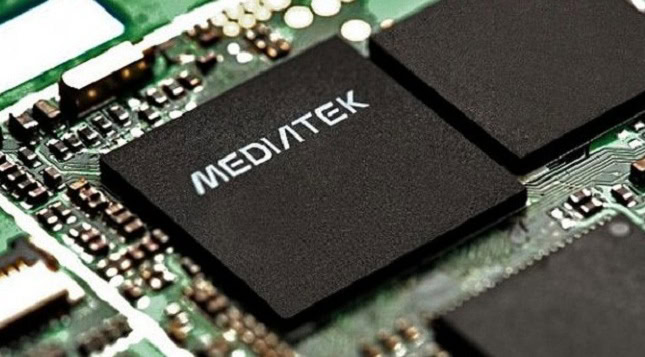
MediaTek is also taking a leaf out of Qualcomm’s book by designing the SoC to be an all in one solution. It will come with built in WiFi, Bluetooth, GPS and FM ratio units, and will also be available in three versions, for built-in HSPA+, 2G, or WiFi only variants. This should make the chip an ideal candidate for emerging market devices, as well as budget products in the higher-end markets.
Despite the quad-core CPU and modern graphics chip, the MT8125 is still aimed at being a power efficient solution for midrange and more budget oriented products. But thanks to improvements in mobile technologies and the falling costs of older components, this chip will still have enough juice to power through the most commonly used applications.
Early last month, MediaTek also announced that it has been working on its own big.LITTLE architecture, similar to that found in the Samsung Exynos 5 Octa. But rather than being an eight core powerhouse, MediaTek’s chip will just be making use of four cores in total.
The chip will be known as the MT8135 and will be slightly more powerful that the budget quad-core MT8125, as it will be using two faster Cortex A15 cores. These power hungry units will be backed up by two low power Cortex A7 cores, so it’s virtually the same configuration as the Exynos 5 Octa but in a 2-by-2 layout (2 A15s and 2 A7s) rather than 4-by-4 (4 A15s and 4 A7s).
But in typical MediaTek fashion, the company has opted to down clock the processor in order to make the chip more energy efficient, which is probably a good thing considering that budget devices tend to ship with smaller batteries. The processor will peak at just 1Ghz, which isn’t super slow, but it is nearly half the speed of the A15s found in the Galaxy S4. But performance isn’t everything, and I’m more than happy to see a company pursue energy efficiency over clock speed and number of cores for once, especially if it brings big.LITTLE to some cheaper products.
Looking to the future
ARM Cortex A57
If you fancy a look even further ahead into the future, then we have also received a little bit of news regarding ARM’s successor to the A15, the all new Cortex A57. This new top of the line chip recently reached the “tape out” stage of development, but it’s still a way off from being released in any mobile products.
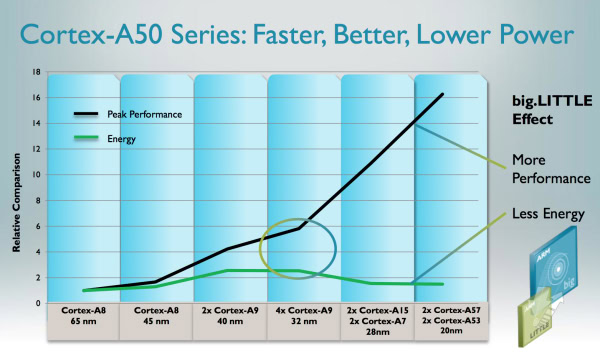
ARM has hinted that its new chip can offer up to triple the performance of the current top of the line Cortex-A15 for the same amount of battery consumption. The new Cortex-A57 will also supposedly offer five times the amount of battery life when running at the same speed as its current chips, which sounds ridiculously impressive.
We heard a while back that AMD was working on a Cortex A57/A53 big.LITTLE processor chip as well, which should offer an even better balance of performance and energy efficiency than the current Exynos 5 Octa. But we’ll probably be waiting until sometime in 2014 before we can get our hands on these chips.
The age of x64
Speaking of ARM’s next line-up of processors, another important feature to pay attention to will be the inclusion of 64 bit processing technology and the new ARMv8 architecture. ARM’s new Cortex-A50 processor series will take advantage of 64 bit processing in order to improve the performance in more demanding scenarios, reduce power consumption, and take advantage of larger memory addresses for improved performance.
We’ve already seen a few mobile memory manufactures talk about production of high speed 4GB RAM chips, which can only be made use of with larger 64 bit memory addresses. With tablets and smartphones both in pursuit of ever higher levels of performance, x64 supported processors seem like a logical step.
So there you have it, I think that’s pretty much all of the big processor news over the past 3 months. Is there anything in particularly which has caught your eye, are you holding out for a device with a brand new SoC, or are the current crop of processors already plenty good enough for your mobile needs?